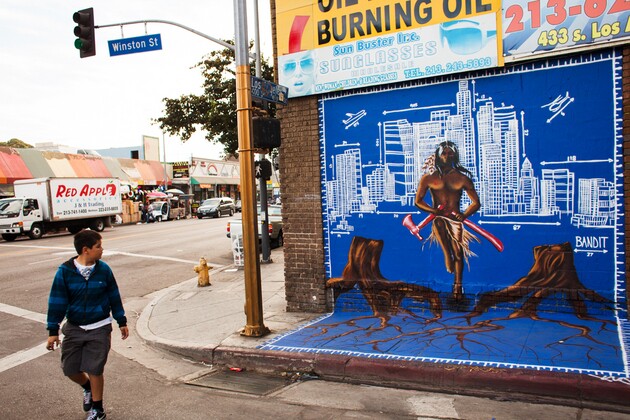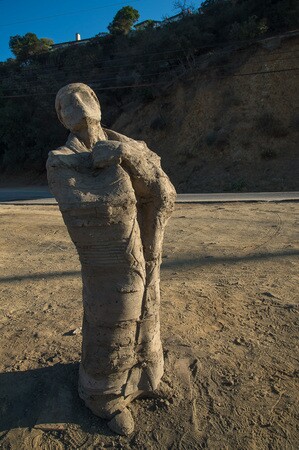Erosion of Native American Culture Subject of Protest and Art

November is Native American Heritage Month, and Stephen Zeigler is working toward making it an urban experience.
While Zeigler stepped away from being part of Downtown Art Walk, the change in leadership encouraged him, and his gallery 118 Winston, to jump back in with vocal advocacy and a street art spirit.
Current work at the gallery, being introduced during Art Walk, is an extension of this week's protests of The Autry, held by the Friends of the Southwest Museum. It adds to Zeigler's cause that he has championed: Native American culture.
"The Autry Museum took over the Southwest Museum's collection of Native American art with the understanding that they would keep the Southwest Museum open," said Zeigler. "It's looking like they will not be following through with that."
On Tuesday, The Friends of the Southwest Museum Coalition protested the management of the museum and how the Native American artifacts have been handled since 2003, when The Autry merged with the Southwest Museum. At the time the Southwest Museum was struggling to keep its doors open, and the building itself, which opened in 1914, needed repairs and upgrades. Since then, the museum has been open with limited hours.
The Autry has always stated that it can't afford to fully operate two museum sites, according to a detailed account in the Los Angeles Times. W. Richard West Jr., the Autry's president, said they are still seeking private and public partnerships, including commercial interests as well as other nonprofit groups.
Advocates like Zeigler are not convinced. "The Southwest Museum has one of the most incredible collections of Native Art in the country," said Zeigler. "Like so much Native-American history and culture, this collection is in danger of being absorbed by a cowboy museum."

Now there is a centerpiece for the Southwest Museum as a metaphor for lost culture, in the form of a soil and straw Navajo Chief statue by Navajo sculptor Erma Yazzie. Designed to look as a warrior standing proud on a hill, it's made of materials dried by the sun. The statue is expected to erode, or "return to the native soil."
"When I was asked to design a figure to represent my tribal connections to the Southwest Museum, I remembered this beautiful picture of a Navajo chief's blanket in a Southwest museum brochure, and that it was displayed on a mannequin in the Southwest," said Yazzie.
The statue is one of a number of works coming out of the Native American Soil Project, co-sponsored by Friends of the Southwest Museum.
Zeigler's Native American advocacy operates at several levels. In 2011,he learned that from 1974 to 1987 a rescue mission that served homeless and alcoholic Native Americans was once housed his building. The rehab center was the United American Indian Involvement (UAII), and Werdin Place at Winston became a "hang-out" while waiting for refuge. It was nicknamed "Indian Alley" at one time, said Zeigler, who as a photographer is the documentarian for the street invasions by artists Calder Greenwood and Wild Life.
At Werdin and Winston, a handcrafted city sign, presumably made by Wild Life, was installed to mark the entrance to the alley.
In August 2013, Zeigler approached Shepard Fairey to replicate his Native American piece, "We Are Still Here," as an addition to the alley's activism. Fairey's mural was first designed in collaboration with Aaron Huey and created to support the Honor The Treaties initiative.
Other works in the project include a mural with the Los Angeles skyline, with a figure of a warrior breaking an axe, titled "An end to the myth of progress." The work is by Bandit, a street artist who engages with different tribes to contemporary art that highlight Native American causes. Also out of 118 Winston's advocacy is a Free Humanity mural at Winston and Los Angeles, with Audrey Hepburn as a humanitarist -- an attempt to bring light to a dark notorious street corner, said Zeigler.
The new works are also tied into bringing awareness to a fading culture, said Zeigler. "We thought that Indian Alley would be a very appropriate setting for these ephemeral works to be displayed and eventually erode back to the earth." He said. "This installation is to raise consciousness regarding the Southwest Museum and Native Heritage."

118 Winston sits at 118 Winston Street, between Los Angeles and Main, south of Fourth Street. The gallery will be open during Art Walk with new paintings and sculptures by Helen Rebekah Garber. Downtown Art Walk is Thursday, November 14.
Photos courtesy of Stephen Zeigler.